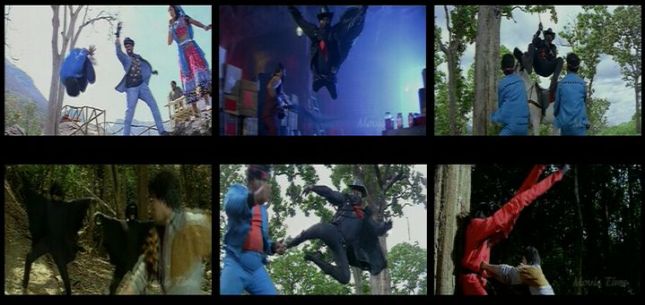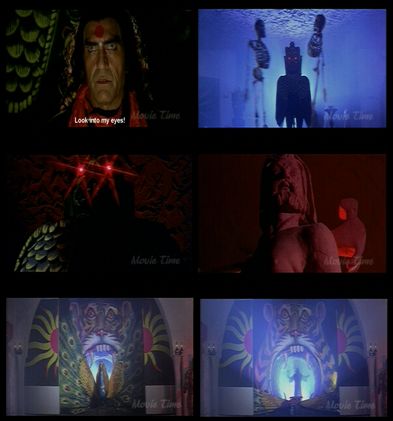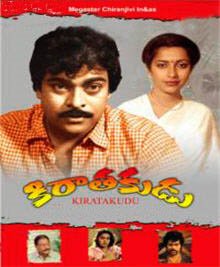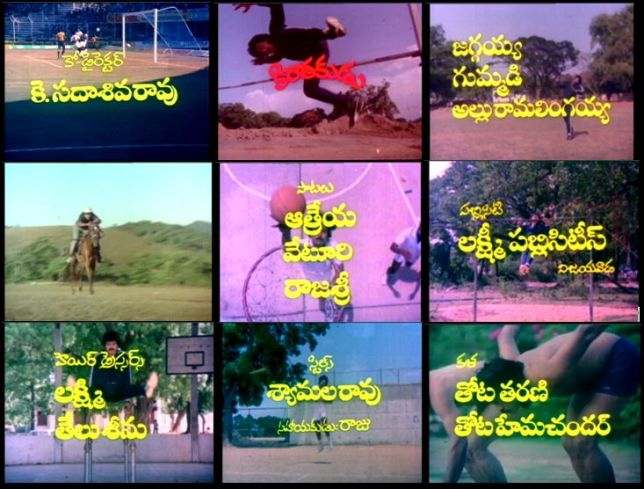Life sometimes throws disappointments my way; shoes that I love on sale but not in my size, clothes with fake pockets, and now Stuartpuram Police Station.
Despite having a top notch cast that includes pretty much everyone you’d expect to see in a 1991 mass film and a good story, which he wrote, Yandamoori Veerendranath makes a muddled mess of a movie.
Rana Pratap (Chiranjeevi) is an honest cop who believes in justice. He returns to his home town of Stuartpuram to find that crooks run the show, and the police are their stooges. This will not do. No. Well, eventually. When Rana Pratap takes time to focus on The Law and not so much on The Ladies. His affections are divided between Alaknanda (Vijayashanti), a sweet and religious girl who is prone to fainting and bursts of focussed violence, and Nirosha, local thief and girl about town.
Chiranjeevi’s introduction was cleverly done through a close up of a very high tech cassette Walkman and headphones. It could only be CHIRU!!!! listening to Sunny by Boney M. So appropriate and yet that levity is not carried through. Rana Pratap is quite dour, and fluctuates between obsessing about how to get his hands on the baddies and obsessing about how to get his hands on Alaknanda. He does all the things that in a non-hero would be called villainous. He bribes a priest to give Alaknanda false advice. He uses Nirosha to set up various criminals and to populate his dance sequences. But really it’s all about loving your family. Rana Pratap’s father was a falsely convicted thief, framed by the same crooked politicians and the like who are still running the show. And Rana had to watch his dad be hanged. So he has a lot of emotional baggage and a reason to want to bring justice to his home.
This is clearly in dire need of Mega Justice. Chiru has good hero skills. He can shoot a knife being thrown at him out of the air, catch it and throw it back at his assailant. The action sequences have their moments but often make even less sense than you’d expect from what is a fairly sane storyline. Rana is lured out to a deserted factory complex where Alaknanda is being molested by a gang of rowdies. Soon Chiru is also tied up but for some reason, perhaps union rules, the rowdies stop rowdying to go get drunk and presumably more rowdy. He coaches Alaknanda to lure them over with some wiggling and grimacing so he can…blatantly chew through the ropes on his wrists and then go the biffo. Perhaps he could have just done that himself without placing her in even more peril. However I liked the way she head-butted one guy who tried to kiss her so the scene is not without compensations. A bit of a drawn out but still fun fight scene ensues and then he…shoots Alaknanda free because who wants to walk a whole 3 metres to safely untie her bonds. A fight with the Big Baddie takes place in an abandoned warehouse full of gas cylinders. What could possibly go wrong! The gas is more of a dry ice fog and the villain decides fighting half naked and wearing a hockey mask is the go. WHY?!?! And Chiru keeps most of his kit on, WHY!?!?!
On the downside Rana Pratap also has the slap happy intolerance for criticism that comes with being a Mass hero and even belts Alaknanda. Not cool. Rana Pratap is a role Chiru can play in his sleep. Perhaps he did. It took 2 hours before Chiru let rip with the one decent “you bastard!” of the film. And it took some major carnage for Rana Pratap to realise that perhaps this story was bigger than just him.
Other than the actual plot Rana Pratap is fixated on that old chestnut. Does he want an angel in the streets or a devil in the sheets? Both? Neither? A little from column A and a little from column B? He certainly makes no secret of his interest in Alaknanda but he doesn’t exactly chase Nirosha away. And he seems even less decisive when they try to swap characteristics. They just don’t understand how this works – he doesn’t want one woman who is everything, he wants all the women who add up to nothing.
Alaknanda is a frustrating character. On the one hand she is religious to the point of it becoming superstition. On the other hand, her credulity allows her to believe Rana Pratap’s rev up speech and go beating up a load of sleazy men at the market.
I feel Vijayashanti really put her all into belting a bloke with a whole bunch of bananas. Being such a delicate young lady, Chiru had to tell Alaknanda where the guy’s nuts were of course. But she quickly learned to stand up for herself, kick arse and take names. She was essential to defeating the baddies in fact. However Rana basically conned Alaknanda into sneaking into his bed, so he is bad news for some forms of agency.
Nirosha is a good match for Chiranjeevi in many ways. She wears fancy high heeled boots even when climbing trees. She likes denim and he loves denim. She steals his uniform and dresses up as Rana Pratap. The lower Rana Pratap unbuttons his shirt the more effective he seems to be at fighting crime and the lower Nirosha unbuttons hers the more compelling her arguments become. They both have higher Brahmi tolerance than I do. And she is game with the choreography, even though their first duet looks more like assorted penguin courtship rituals than The Art of Dance.
Song wise I think Nirosha might in front because she gets to be in the craptacular Bank of Beauty song, which is Chiru’s blingiest and most fun number for this film. She and Alaknanda were both instrumental in the big finale, and it was nice to see the nominal bad girl might have a bright future.
There are really no surprises in the story. Some scenes appear to be hamfisted attempts to recreate something that took Yandamoori’s eye in another movie and that are not really necessary. The flashbacks are long and misjudged. The fight scenes and some of the violence is quite graphic as people are stabbed, shot, set on fire or hacked at with axes and yet it lacks impact in a dramatic sense. Also the framing is often odd, with all the people crammed in to one corner of the screen or missing the top of their heads, with occasional weird jerky transitions and they stealthily try and get everyone back in the shot. Despite all the mayhem, it’s not compelling unless Chiru is on the screen. And even then it’s a struggle to go the distance with this film.
The cast is solid, the idea was good. What a shame. 2 ½ stars!
Bonus pic – this might have been a reasonable cake. But a baddie had to spoil everything by cutting it with a knife coated in blood. Sigh. Another waste of effort.






































































